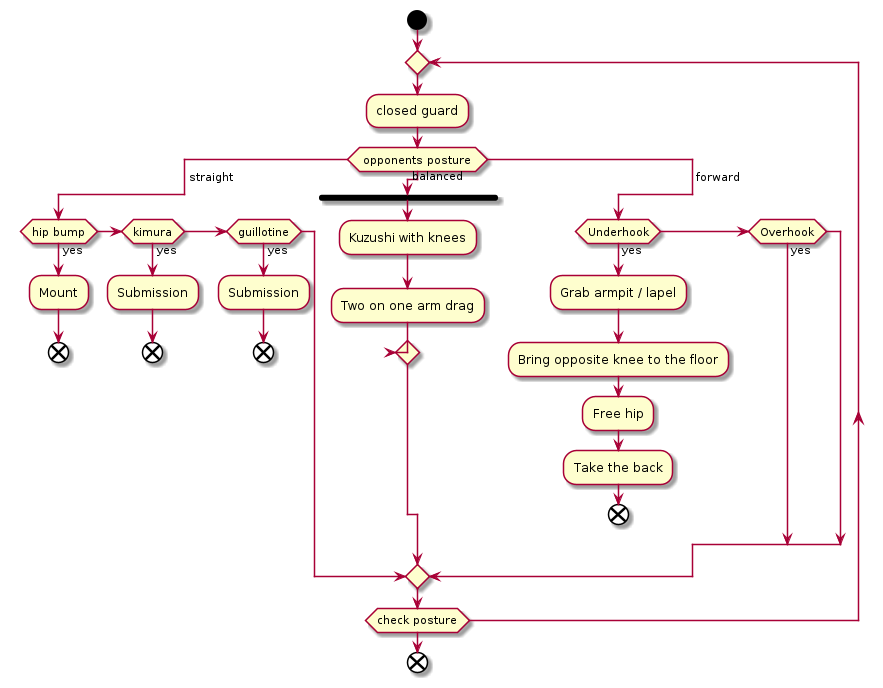
Intro Link to heading
I am a 40+ software engineer and recreational Jiu Jitsu practitioner, struggling with vast amount of information related to the sport. I decided to make use of my `computer` skills to aid me in the process of taming this new skill.
In this post I am going to discuss about flowcharts and more specifically about:
- why bother with flowcharts
- tools for creating flowcharts
- integrating flowcharts with with wiki
What is a flowchart ? Link to heading
A flowchart is a diagram of the sequences of movements or actions of people or things involved in a complex system or activity.
In the sport of Jiu Jitsu the `activity` may be a technique or a series of techniques one needs to perform to either submit the oppoent or to get into an advantageous position. In other words a flowchart a graphical representation of the steps that constitue one or more techniques.
Why use flowcharts ? Link to heading
Visualization helps the process of learning and also helps the brain retain information. No wonder why people who exibit impressive memory skills often use visualization based techniques like the `Memory Palace` etc.
For material that is already known, using flowcharts really helps refreshing ones memory, as it’s much faster than going through the original material. It’s also something that one can easily print, add notes on top of it and so on.
For new material, creating flowcharts assists comprehension and reinforces learning.
Last but not least, flowcharts can act as an index that can help you to easily navigate to a `step` of interest.
Flowcharting tools Link to heading
There are tons of flowcharting tools out there. I am interested only in tools that define a domain specific language mostly because we can use scripts to generate them (or parts of them). WYSIWYG (what you see is what you get) tools might be more appealing to some users, but apparently these people are not my target audience.
Other qualities of a flowcharting tool includes:
- ease of use
- verbosity
- quality of feedback (error messages)
- integrations
- editor support
- web / wiki support
This post is going to focus on three of the most popular choices out there:
PlantUML Link to heading
PlantUML is a component that allows users to easily create UML diagrams. UML is a modeling language used in software engineering and one of the diagrams it uses is the activity diagram, which is pretty much a flowchart.
PlantUML uses a client/server architecture, so it usually requires internet access. Usually? Well, it allows you to run the servre locally too (without much hussle).
The tool has integration with tons of tools and services and is generally a solid choice.
Here’s an example diagram for closed guard:
| |
#+RESULTS

I have been using PlantUML a lot for creating BJJ related flowcharts and my only complaint is its verbosity. Especially, for non-developers it might seem a bit too much.
yuml Link to heading
yuml is pretty similar to PlantUML with less verbose syntax. In fact, it completely lacks keywords and only uses symbols. So, in a sense it feels like creating the diagram in ascii. It’s also supported out of the box in mdwiki using mdwiki gimmicks.
It also reqires internet access as the rendering happens by their online server. One downside compared to the competition is that I didn’t find a way to include clickable parts inside the generated graph. This seems to be an option in the other two tools.
| |
 Much simpler to write, but the diagram itself does not look as tidy as the previous one.
Much simpler to write, but the diagram itself does not look as tidy as the previous one.
Flowchart JS Link to heading
The last contender is flowchart.js. This project focuses exclusively on flowcharts instead of UML (as was the case for the previous tools).
Syntax wise is similar to yuml, however, it does require you addtionally define the type and content of each node in the graph.
| |

A benefit compared to the above is that it seems to work completely offline. Also, the for the generated graph has a professional quality.
The downside is that syntactical errors are pretty hard to diagnose and some times the way the graph is rendered is weird.
Using flowcharts in your wiki Link to heading
mdwiki supports extensions called gimmicks which are special markdown elements that provide rich functionality. One such gimmick is yuml. The code below when added to your wiki will be rendered as a diagram:
| |
I implemented equivallent gimmicks for both PlantUML and flowchart.js and they can be found in my mdwiki Docker image `iocanel/mdwiki:2022.01` or just `iocanel/mdwiki:latest`. If you don’t want to use it via docker, then just grab my `index.html` and `lib` folders from: https://github.com/iocanel/dockerfiles/tree/master/net/mdwiki.
These custom gimmicks however, istead of accepting the code `inline` the accept it as a file. So you just place the file with diagram code inside your wiki and then use:
| |
and for flowchart.js:
| |
Post index Link to heading
- Hackers guide to Jiu Jitsu: intro wordpress version github version
- Hackers guide to Jiu Jitsu: ffmpeg wordpress version github version
- Hackers guide to Jiu Jitsu: mplayer wordpress version github version
- Hackers guide to Jiu Jitsu: markdown wiki wordpress version github version
- Hackers guide to Jiu Jitsu: flowcharts wordpress version github version